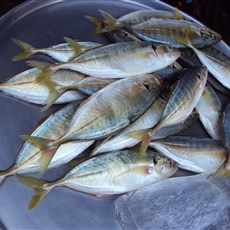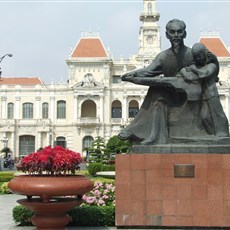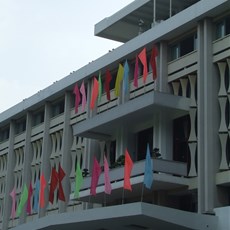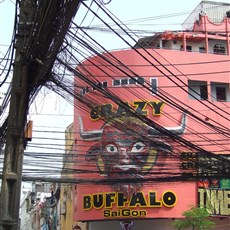2009 Biking Vietnam
We ended our one month trip in Saigon, the
capital of South Vietnam
from 1956 to 1975 when it fell to the communist north and was renamed Ho Chi
Minh City (HCMC). We visited the People’s Committee Building (built in the
early-1900s by the French); the Reunification Palace (originally the French
governor’s residence, it was occupied by President Diem after the French
departed Vietnam; Diem was so unpopular his own air force bombed the palace in
1962, but did not kill him; a new residence – with a bomb shelter – was built
on the same site; Diem never saw it completed as he was assassinated by his
troops in 1963; on 30 April 1975, a communist tank burst through the gate and a
Viet Minh soldier ran up the stairs to unfurl a North Vietnam flag on the
fourth floor; he then met with the President of the south who said: “I have
been waiting since morning to hand over power to you”; the soldier responded:
“You cannot hand over what you do not have”; the palace is used today for state
occasions); the War Remnants Museum (originally called the Museum of American
War Crimes, the museum is both devastating and one-sided**); but mainly we
walked the vibrant streets and dined well.
** Beware propaganda in Vietnam. While
French and American atrocities are well-documented, no mention at all is made
of communist atrocities and very few of South Vietnamese atrocities.

Saigon market

Saigon market

Ho Chi Minh City People's Committee building

Ho Chi Minh City Reunification palace

Saigon
History in brief
First independent Vietnamese state
founded almost 5,000 years ago
111BC China
annexed the Red River delta beginning 1,000
years of Chinese rule
938AD Chinese defeated by Vietnamese
1010 Hanoi
founded as new capital of Vietnam
Early-1400s China reoccupied Vietnam
1428 Chinese defeated by Le Loi who
became first in long line of Le dynasty emperors
1471 Vietnamese defeat Chams
1516 Portuguese land at Danang, set up
trading post, convert some to Catholicism
1765 Tay Son Rebellion led by Nguyen
brothers; Emperor Gia Long takes throne; Nguyen dynasty born ruling until 1945;
country united for first time in 200 years
1825 Emperor Minh Mang imprisons and
persecutes missionaries – gives French excuse to intervene
By mid-1880s French colonial empire in
southeast Asia comprises Vietnam
(Tonkin (North), Annam
(Central), and Cochinchina (South)), Cambodia
and Laos
Start of 70 years of colonial control
(active resistance throughout)
1911 Ho Chi Minh leaves Vietnam, 1925
establishes forerunner of Vietnamese Communist Party
During World War II Vietnam administered by Vichy
France
under Japanese occupation
1941, the Viet Minh (communists under Ho
Chi Minh) began a revolt against French rule and Japanese occupation supported
by OSS (CIA)
After persuading Emperor Bao Dai to
abdicate in his favour, on 2 September 1945 President Ho declared independence
for the Democratic Republic of Vietnam
French with British help re-established
colonial control – bitter fighting ensued
South Vietnam (anti-communist) was
granted independence in 1949
In 1950 Ho again declared an independent
Democratic Republic of Vietnam – recognized by China
and the Soviet Union
1954 Ho defeated the French at Dien Bien Phu
Geneva Accord signed 1954: supported the
territorial integrity and sovereignty of Indochina; granted it independence
from France;
declared the cessation of hostilities and foreign involvement; delineated
northern and southern zones into which opposing troops were to withdraw;
mandated unification on the basis of internationally supervised free elections
to be held in July 1956
Neither the US
nor South Vietnam
signed the Geneva Accords – bear in mind the Cold War years and genuine fear of
communism
1954 marked the beginnings of US involvement in Vietnam which led to the Vietnam
War
Laos
and Cambodia
also became independent in 1954, but were both drawn into the Vietnam War
Vietnam War (American War) – stats
The Vietnam War, known as the American War
in Vietnam, was fought primarily in South Vietnam between Diem’s government
forces aided by the United States and guerrilla forces (the Viet Cong) aided by
North Vietnam
58,148 Americans were killed and 304,000
wounded out of 2,59 million who served.
The average age of those killed in Vietnam was
23,11 years
The average infantryman in the South
Pacific during World War II saw about 40 days of combat in four years. The
average infantryman in Vietnam
saw about 240 days of combat in one year, thanks to the mobility of the
helicopter
From 1957 to 1973 the National Liberation
Front assassinated 36,725 South Vietnamese and abducted 58,499. Death squads
focused on leaders that included schoolteachers and minor officials
South Vietnamese dead were estimated at
more than 400,000, and Viet Cong and North Vietnamese at over 900,000
One out of every 10 Americans who served
in Vietnam
was a casualty. Although the percentage who died is similar to other wars,
amputations or crippling wounds were 300 percent higher than in World War II.
75,000 Vietnam
veterans are severely disabled
Two-thirds of the men who served in Vietnam were
volunteers
Civilian deaths were put at two million
in the north and south
The war began soon after the Geneva
Conference (1954) provisionally divided Vietnam
into the Democratic Republic of Vietnam (North
Vietnam) and the Republic
of Vietnam (South Vietnam)
It escalated from a Vietnamese civil war into
a limited international conflict in which the United
States was deeply involved, and did not end, despite
peace agreements in 1973, until North Vietnam's
successful offensive in 1975 resulted in South
Vietnam's collapse and the unification of Vietnam by the
North